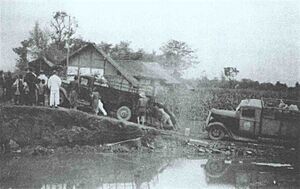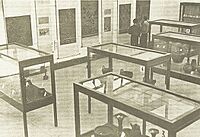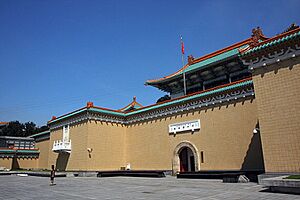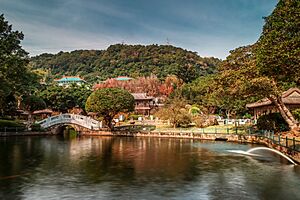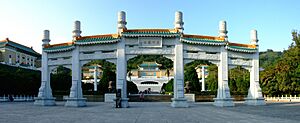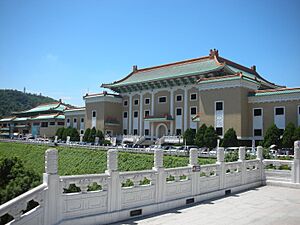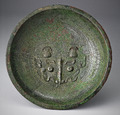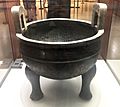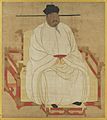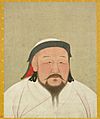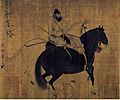National Palace Museum facts for kids
| 國立故宮博物院 | |||||||||||||||||||||||||
 |
|||||||||||||||||||||||||

|
|||||||||||||||||||||||||
| Established | 10 October 1925 (in Forbidden City, Beijing) 12 November 1965 (in Taipei, Taiwan) |
||||||||||||||||||||||||
|---|---|---|---|---|---|---|---|---|---|---|---|---|---|---|---|---|---|---|---|---|---|---|---|---|---|
| Location | Shilin, Taipei | ||||||||||||||||||||||||
| Type | National museum | ||||||||||||||||||||||||
| Collections | 698,887 (as of November 2024[update]) | ||||||||||||||||||||||||
| Visitors | Northern branch: 1,874,994 (2024) Southern branch: 996,713 (2024) |
||||||||||||||||||||||||
| Architect | Huang Baoyu (Northern Branch) Kris Yao (Southern Branch) | ||||||||||||||||||||||||
| Chinese name | |||||||||||||||||||||||||
| Traditional Chinese | 國立故宮博物院 | ||||||||||||||||||||||||
| Simplified Chinese | 国立故宫博物院 | ||||||||||||||||||||||||
|
|||||||||||||||||||||||||
The National Palace Museum, also called the Taipei Palace Museum, is a famous national museum in Taipei, Taiwan. It first opened in Beijing in 1925. Later, it was re-established in Shilin, Taipei, in 1965. A second location, the southern branch, opened in Taibao, Chiayi, in 2015.
The museum has a huge collection of almost 700,000 ancient items and artworks. Most of these treasures were moved from the Beijing Palace Museum and other places in mainland China. This happened when the government of the Republic of China moved to Taiwan. Before the museum opened in Taipei in 1965, these collections were kept in different places across Taiwan.
The museum's collection covers 8,000 years of history. It shows a full record of Chinese history from ancient times to today. Like the Palace Museum in Beijing, this museum's many artifacts come from the old imperial collections. These were gathered by the Ming and Qing dynasty emperors in the Forbidden City.
Contents
Museum History
Early Days in Mainland China
The National Palace Museum first opened as the Palace Museum in the Forbidden City on October 10, 1925. This was soon after Puyi, China's last emperor, left the Forbidden City. The museum's first items were valuable treasures that belonged to the old imperial family.
In 1931, when there was fighting in the region, the government decided to move the museum's most valuable pieces. This was to keep them safe from the Imperial Japanese Army. So, from 1933, many crates of objects were moved from Beijing to Shanghai.
In 1936, the collection moved again to Nanjing. As the Japanese army moved further into China during World War II, the collection was moved even more. It traveled west to places like Anshun and Leshan. The treasures stayed safe until Japan surrendered in 1945. In 1947, they were shipped back to Nanjing.
Moving to Taiwan
After World War II, the Chinese Civil War started again. Generalissimo Chiang Kai-shek decided to move many artworks to Taiwan. Taiwan had been given back to the Republic of China in 1945. As the fighting got worse in 1948, the National Beijing Palace Museum and five other groups decided to send some of their best items to Taiwan.
Hang Li-wu, who later became the museum's director, helped move the collection. Three groups of items were shipped from Nanjing to Keelung, Taiwan, between December 1948 and February 1949. By the time the items arrived in Taiwan, not all of the collection could be sent. Only 2,972 crates of artifacts from the Forbidden City made it to Taiwan. This was about 22% of the original crates, but they were some of the very best pieces.
The collections from several museums and libraries were first stored in a railway warehouse in Yangmei. Later, they moved to a sugar mill near Taichung. In 1949, a special office was created to manage these collections. For safety, this office chose a mountain village called Beigou in Wufeng, Taichung, as the new storage place. The collection from the sugar mill was moved there the next year.
In 1956, the office received money to build a small exhibition hall. This hall opened in March 1957. It had four galleries where more than 200 items could be shown.
In 1960, the office received more money to build a new, larger museum. The government of Taiwan also helped with funds. The new museum in the Taipei suburb of Waishuanxi was finished in August 1965. It was named the "Chung-Shan Museum" to honor Sun Yat-sen, a founding father of Taiwan. The museum opened to the public on Sun Yat-sen's birthday. Since then, the museum in Taipei has taken care of and shown these important collections.
Museum Buildings
Northern Branch
The main building of the National Palace Museum in Taipei was designed by Huang Baoyu. It was built from 1964 to 1965. Because there wasn't enough space to show all 600,000+ items, the museum was made bigger in 1967, 1970, 1984, and 1996. In 2002, the museum had a big renovation that cost US$21 million. This made the museum more spacious and modern. About two-thirds of the museum was closed during this time. It officially reopened in February 2007.
The museum changes its painting and calligraphy exhibits every three months. About 3,000 pieces from the collection can be seen at one time. Even though these exhibits are short, they are very popular. In 2014, the museum had three of the most visited exhibitions in the world.
Zhishan Garden
Inside the museum's area is the Zhishan Garden. This garden is designed in the classical Chinese style of the Song and Ming periods. It covers about 1.88 hectares (4.6 acres). The garden uses ideas from feng shui, Chinese architecture, and landscape design. It has many ponds, water features, and wooden Chinese pavilions. It was finished and opened in 1985. There is also another garden nearby called the Zhide Garden.
Chang Dai-chien Residence
The National Palace Museum also looks after the home of Chinese painter Chang Dai-chien. This home is also in Shilin, Taipei. It is known as the Chang Dai-chien Residence or the Abode of Maya. It was built between 1976 and 1978. It is a two-story building with Chinese-style gardens. After Chang passed away in 1983, his house and gardens were given to the National Palace Museum. They are now a museum and a memorial.
Southern Branch
The Southern Branch of the National Palace Museum is in Taibao, Chiayi County, Taiwan. It is built on 70 hectares (170 acres) of land. There is also a lake and an Asian-style garden on the grounds. Plans for this southern branch started in 2000. The building was designed by the Taiwan-based firm Artech Inc. It is built to be strong against earthquakes and floods.
The project cost NT$7.9 billion (about US$268 million). The museum itself is 9,000 square meters (97,000 sq ft) in size. It had its grand opening on December 28, 2015. However, it had some water leakage problems and had to close in April 2016. After repairs, the Southern Branch reopened on August 23, 2016.
Museum Collections
| Categories | Numbers |
|---|---|
| Bronzes | 6,245 |
| Ceramics | 25,602 |
| Jades | 13,478 |
| Lacquerwares | 773 |
| Enamel wares | 2,520 |
| Carvings | 666 |
| Studio implements | 2,379 |
| Coins | 6,953 |
| Miscellaneous objects (religious implements, costumes and accessories, and snuff bottles) |
12,495 |
| Paintings | 6,762 |
| Calligraphic works | 3,745 |
| Calligraphic model books | 495 |
| Tapestries and embroideries | 308 |
| Fans | 1,882 |
| Rubbings | 900 |
| Rare books | 216,507 |
| Qing archival documents | 395,551 |
| Textiles | 1,626 |
| Total | 698,887 |
The museum has done a full check of its items three times since 1948. The museum has Chinese calligraphy, porcelain, bronzes, paintings, jades, and many other artifacts. About 22% of the original boxes from the Forbidden City were brought to Taiwan. Other items have been added through transfers from other places, donations, and purchases. Many of these artifacts were brought by Chiang Kai-shek before his forces left mainland China in 1949.
The museum now has almost 700,000 artifacts that are very important historically or artistically. With such a large collection, only about 1% of the items are shown at any given time. The rest of the collection is kept safe in special rooms with controlled temperatures.
The museum has several famous items that are known around the world. The ancient items in the National Palace Museum cover thousands of years and many different types of art.
Metalwork Treasures
Among the bronze items, the Zong Zhou Zhong (Bell of Zhou) is a very important musical instrument. It was made by order of King Li of Zhou. The Mao Gong Ding (Cauldron of Duke of Mao) from the late Western Zhou dynasty (1046–771 BCE) has the longest Chinese bronze writing found so far.
In 1995, the museum got the Taihe Shakyamuni. This is a statue of The Buddha from the Northern Wei Dynasty. It shows a big change from early Indian art to Chinese Buddhist art.
Amazing Ceramics
The museum has the world's largest collection of Ru ware, with 21 pieces. This is one of the rarest Chinese ceramics. It was made only for the emperor's court. It is one of the Five Great Kilns of the Song dynasty (960–1279). The museum also has major collections from the other great kilns. These include beautiful porcelains from the Ming (1368–1644) and Qing (1644–1912) dynasties.
Unique Carvings
One of the most popular jade carvings is the Jadeite Cabbage. This piece of jadeite is carved to look like a cabbage head. It even has a large and a small grasshopper hidden in the leaves. The artist used the natural colors of the jade to make the cabbage look real.
The Meat-shaped Stone is often shown with the Jadeite Cabbage. This piece of jasper, a type of agate, uses its natural layers to look like a piece of pork cooked in soy sauce. The colors and textures make it look incredibly real, with layers of skin, lean meat, and fat.
The museum also displays carvings made from bamboo, wood, ivory, rhinoceros horn, and fruit pits. The Carved Olive-stone Boat is a tiny boat carved from an olive pit. It has a covered deck and windows that can move. Inside, there are chairs, dishes on a table, and eight tiny figures. The bottom of the boat has the entire 300-character story of Su Shih's Latter Ode on the Red Cliff carved into it.
Paintings and Calligraphy
The paintings in the National Palace Museum date from the Tang dynasty (618–907) to modern times. The collection covers over a thousand years of Chinese painting. It includes many styles, like landscapes, flowers and birds, and people. One of the most popular paintings is the Qing Palace Version of Along the River During the Qingming Festival. This was painted by five Qing dynasty court painters. Dwelling in the Fuchun Mountains by Huang Gongwang is a very rare and dramatic work. Walking on a Mountain Path in Spring is another important painting.
The museum also has a huge collection of calligraphy works. These are from famous calligraphers, scholars, and important officials throughout history. The calligraphy works date from the Jin (266–420) and Tang (618–907) dynasties, showing many different styles.
Rare Books and Documents
The rare books in the National Palace Museum range from the Song (960–1279) and Yuan (1271–1368) dynasties to the Ming (1368–1644) and Qing (1644–1912) dynasties. There are over 200,000 volumes. Examples include the Yongle Encyclopedia and Complete Library of the Four Treasuries.
Historical documents in the museum include Jiu Manzhou Dang. This is a set of Manchu records that are a main source for early Manchu history. Other official documents, like court records, are also available for studying the history of the Qing dynasty.
Exhibitions Around the World
The museum does not hold exhibitions in mainland China. This is because of worries that the artifacts might be taken due to the political status of Taiwan. Since the museum opened in Taipei in 1965, it has only had six large overseas exhibitions. These were in countries that have laws to protect the treasures from being taken by legal claims. These countries were the United States (1996), France (1998), Germany (2003), Austria (2008), Japan (2014), and Australia (2019).
Some past overseas exhibitions include:
- 1935: "London International Exhibition of Chinese Art" in London.
- 1940: "Chinese Art Exhibition" in Moscow and Leningrad.
- 1961: "Ancient Chinese Art Exhibition" in the United States.
- 1973: "China Exhibition" in Seoul, South Korea.
- 1996: "Splendors of Imperial China" in the United States.
- 1998: "Empire of Memory" in Paris, France.
- 2003: "Treasures of the Son of Heaven" in Germany.
- 2008: "Imperial Treasures" in Vienna, Austria.
- 2014: "The Treasured Masterpieces from the National Palace Museum, Taipei" in Japan.
- 2019: "Heaven and Earth in Chinese Art" in Australia.
Museum Leadership
The National Palace Museum is part of the government in Taiwan. It has had many directors over the years. In 1949, a special office was set up to manage the collections. In 1955, this office became the Joint Managerial Office for the National Palace Museum and National Central Museum.
List of Directors
| Name | Term Begin | Term End |
|---|---|---|
| Directors of Palace Museum | ||
| Li Yü-ying | First appointed Director-General | |
| I P'ei-chi | October 1925 | October 1933 |
| Ma Heng | October 1933 | August 1949 |
| Directors of National Central Museum Preparatory Office | ||
| Fu Ssu-nien | 1933 | 1934 |
| Li Chi | 1934 | 1949 |
| Directors of the Joint Managerial Office of the National Palace Museum and National Central Museum | ||
| Hang Li-wu | September 1949 | June 1956 |
| K'ung Te-ch'eng | July 1956 | April 1964 |
| Ho Lien-k'uei | May 1964 | August 1965 |
| Directors of National Palace Museum | ||
| Chiang Fu-ts'ung | September 1965 | January 1983 |
| Ch'in Hsiao-yi | January 1983 | May 2000 |
| Tu Cheng-sheng | 20 May 2000 | 20 May 2004 |
| Shih Shou-chien | 20 May 2004 | 25 January 2006 |
| Lin Mun-lee | 25 January 2006 | 20 May 2008 |
| Chou Kung-shin | 20 May 2008 | 29 July 2012 |
| Chou Chu-kun (acting) | 30 July 2012 | 18 September 2012 |
| Feng Ming-chu | 18 September 2012 | 19 May 2016 |
| Lin Jeng-yi | 20 May 2016 | 15 July 2018 |
| Chen Chi-nan | 16 July 2018 | 13 January 2019 |
| Lee Ching-hui (acting) | 14 January 2019 | 14 February 2019 |
| Wu Mi-cha | 15 February 2019 | 30 January 2023 |
| Hsiao Tsung-huang | 31 January 2023 | Incumbent |
Images for kids
-
Taihe Shakyamuni, Northern Wei, 477
-
The Jadeite Cabbage, 19th century
-
The Seated Portrait of Emperor Taizu of Song, c. 960–76
-
The Travelers Among Mountains and Streams, by Fan Kuan, c. 1000
-
The Wind in Pines Among a Myriad Valleys, by Li Tang, 1124
-
The Walking on a Mountain Path in Spring, by Ma Yuan, 13th century
-
The Seated Portrait of Xuande Emperor, c. 1425–35
-
The Portrait of Kublai Khan, by Liu Guandao, c. 1271–94.
See also
 In Spanish: Museo Nacional del Palacio para niños
In Spanish: Museo Nacional del Palacio para niños
- List of most visited art museums
- List of largest art museums
- List of museums in Taipei
- List of museums in Taiwan


